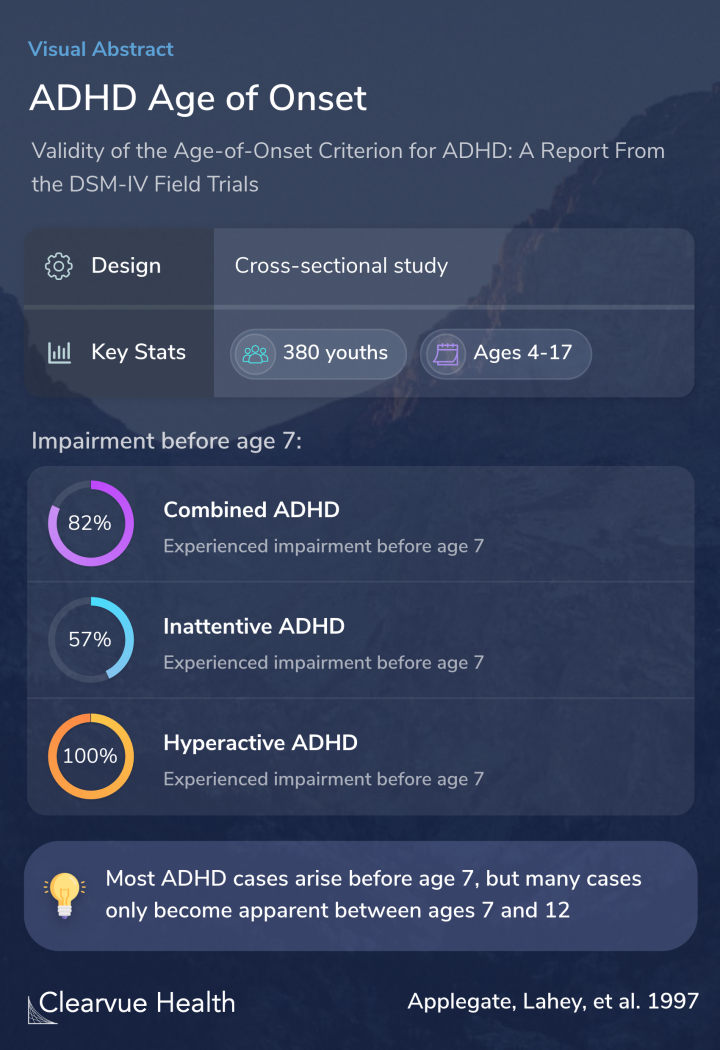Validity of the Age-of-Onset Criterion for ADHD: A Report From the DSM-IV Field Trials
ADHD: Age of symptom onset and impairment
B Applegate, B B Lahey, E L Hart, J Biederman, G W Hynd, R A Barkley, T Ollendick, P J Frick, L Greenhill, K McBurnett, J H Newcorn, L Kerdyk, B Garfinkel, I Waldman, D Shaffer

Objective
This study provides valuable information on when parents and teachers can expect to see ADHD symptoms in children.
The fourth edition of the DSM, a professional psychiatry manual, required significant impairments from ADHD symptoms before age 7.
Traditionally, it was thought that ADHD could only start in children before age 7. Someone could be diagnosed later in life, but to properly qualify as ADHD, they would have needed significant symptoms and impairment before age 7.
This study was crucial in helping to determine the definition of ADHD for the fifth edition of the DSM. Today, ADHD symptoms can begin before age 12, rather than age 7, by definition.
To examine the validity of the DSM-IV requirement of an age of onset of impairment due to symptoms before 7 years of age for the diagnosis of attention-deficit/hyperactivity disorder (ADHD).
Method
This study wanted to see when individuals with ADHD typically start showing symptoms to examine the age criteria for ADHD critically.
If there were a significant number of individuals with ADHD symptoms, who only showed signs after 7, the definition of ADHD might need to be revised.
The validity of this criterion was examined in a clinic sample of 380 youths aged 4 through 17 years by comparing youths who met symptom criteria for ADHD and either did or did not display impairment before age 7 years.
Results
Researchers found that most, but not all, of the children with ADHD in the study experienced symptoms and impairment before age 7.
Researchers noted that typically, parents noticed symptoms around 2 to 3 years before symptoms began significantly impacting their children.
All children with hyperactive-type ADHD symptoms in the study experienced symptoms before age 7, suggesting that hyperactive symptoms start showing early.
However, only 57% of those inattentive type ADHD showed symptoms and impairment before age 7.
This gap suggests that the age seven criteria may miss many cases of inattentive ADHD.
Some individuals in the study who did not have impairment before age seven still had symptoms before age seven.
This means that some kids will start having ADHD symptoms when they are younger, but the symptoms won’t be severe enough to impact their life significantly.
Most of the children who had symptoms or impairment that began after age 6 had difficulties in school, suggesting that these children indeed had ADHD despite their late start and that their ADHD affected their life.
Nearly all youths who met symptom criteria for the predominantly hyperactive-impulsive subtype also met the age of onset of impairment criterion, but 18% of youths who met symptom criteria for the combined type, and 43% of youths who met symptom criteria for the predominantly inattentive...
Conclusions
This study was vital in determining the age criteria for ADHD. Previously, researchers had required symptoms and impairments before age 7 for a patient to qualify for ADHD.
This study provided evidence that the criteria above captured most, but not all, valid cases of ADHD.
While most children show symptoms and impairment before age 7, some can have ADHD begin later in life, particularly if they have inattentive type ADHD.
One potential explanation for why this may be the case, as theorized by the authors, is that children who have difficulty paying attention can often get by just fine for years until schoolwork becomes more difficult.
These findings raise questions about the validity of the DSM-IV definition of age of onset of ADHD. Marked differences in the ages of onset of both symptoms and impairment for the three subtypes of ADHD support the validity of distinguishing among these subtypes in DSM-IV.